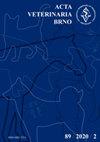Cultivable bacterial diversity of the canine dental plaque as a potential source of bacterial infections
IF 0.7
4区 农林科学
Q3 VETERINARY SCIENCES
引用次数: 2
Abstract
Dental diseases are a persistent problem, not only in humans, but very often in companion animals as well. Aetiological agents of these diseases are the dental plaque bacteria. In the present study, we focused on identifying cultivable bacteria living in the dental plaque of dogs, specifically dogs suffering from the early stages of periodontal disease. Canine oral bacteria pose a risk to humans that get bitten by the dog, but they also have a zoonotic potential. Dental plaque samples were taken from five dogs of small breeds. Samples were cultured under aerobic and anaerobic conditions on several types of microbiological agars. All obtained and selected bacterial colonies were identified by PCR with universal primers for the 16S rRNA gene and the sequences of the 16S rRNA gene were compared with the sequences available in the GenBank database using BLASTn analysis. A total of 75 bacteria belonging to five phyla, predominantly to Firmicutes and Proteobacteria, were identified. The most frequent species was Pasteurella canis which was detected in all samples. In addition, representatives of the genera Actinomyces, Bacillus, Bacteroides, Corynebacterium, Frederiksenia, Fusobacterium, Haemophilus, Lactobacillus, Leucobacter, Neisseria, Ottowia, Porphyromonas, Pseudomonas, Staphylococcus, Stenotrophomonas and Streptococcus were detected in the samples. In the present study, a broad spectrum of bacteria in dental plaque samples, including canine periodontal pathogens such as Porphyromonas gulae or Porphyromonas macacae were identified. In addition, highly pathogenic bacteria, specifically Actinomyces hordeovulneris, Bacillus circulans, and Bacteroides pyogenes, which pose a serious risk to human health, were detected in samples.犬牙菌斑的可培养细菌多样性是细菌感染的潜在来源
牙齿疾病是一个持续存在的问题,不仅发生在人类身上,而且经常发生在伴侣动物身上。这些疾病的病因是牙菌斑细菌。在本研究中,我们重点鉴定了生活在狗牙菌斑中的可培养细菌,特别是患有牙周病早期的狗。犬类口腔细菌对被狗咬伤的人类构成风险,但它们也具有人畜共患的潜力。牙菌斑样本取自五只小型犬。样品在好氧和厌氧条件下在几种微生物琼脂上培养。使用16S rRNA基因的通用引物通过PCR鉴定所有获得和选择的菌落,并使用BLASTn分析将16S rNA基因的序列与GenBank数据库中可用的序列进行比较。共鉴定出75种细菌,分属五个门,主要是厚壁菌门和变形菌门。最常见的物种是在所有样本中都检测到的犬巴氏杆菌。此外,样品中还检测到放线菌属、芽孢杆菌属、拟杆菌属、棒状杆菌属、弗雷德里克菌属、梭杆菌属、嗜血杆菌属、乳酸杆菌属、白杆菌属、奈瑟菌属、Ottowia属、卟啉单胞菌属、假单胞菌属,葡萄球菌属,狭窄单胞菌和链球菌属的代表。在本研究中,在牙菌斑样本中鉴定了广谱细菌,包括犬牙周病原体,如古氏卟啉单胞菌或猕猴卟啉单胞杆菌。此外,在样本中检测到对人类健康构成严重风险的高致病性细菌,特别是部落放线菌、循环芽孢杆菌和化脓性拟杆菌。
本文章由计算机程序翻译,如有差异,请以英文原文为准。
求助全文
约1分钟内获得全文
求助全文
来源期刊

Acta Veterinaria Brno
农林科学-兽医学
CiteScore
1.00
自引率
33.30%
发文量
36
审稿时长
18-36 weeks
期刊介绍:
ACTA VETERINARIA BRNO is a scientific journal of the University of Veterinary and Pharmaceutical Sciences in Brno, Czech Republic.
The scientific journal Acta Veterinaria Brno is dedicated to the publication of original research findings and clinical observations in veterinary and biomedical sciences. Original scientific research articles reporting new and substantial contribution to veterinary science and original methods that have not been submitted for publication elsewhere are considered for publication. A written statement to this effect should accompany the manuscript, along with approval for publication by the author´s head of department. The authors bear full responsibility for the contents of their contribution. Book reviews are published, too.
 求助内容:
求助内容: 应助结果提醒方式:
应助结果提醒方式:


